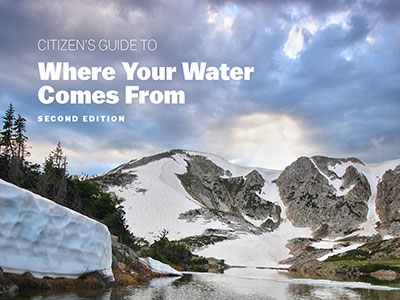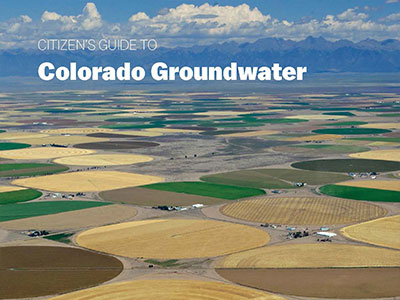Water Cycle
All of the water on Earth takes part in an endless and dynamic process of circulation between the atmosphere, the oceans and the land called the hydrologic cycle, or the water cycle. This cycle includes the processes of evaporation, transpiration, precipitation, overland flow, infiltration, runoff and groundwater flow. Water vapor produced by surface evaporation and transpiration from plants forms clouds, which return the water to the surface in the form of precipitation.
%
Approximate percent of precipitation that falls in Colorado only to return to the atmosphere through evapotranspiration, the combination of evaporation from exposed moist surfaces and transpiration from vegetation
Water Cycle & Groundwater
The amount of infiltration or recharge to groundwater depends on land use, soil properties, and moisture content, as well as the intensity and duration of precipitation. When rainfall is intense, exceeding the rate it can infiltrate into the ground, water accumulates on the land surface and flows downhill as overland flow into streams, lakes or drainages to produce runoff.
Water that infiltrates the ground surface becomes soil moisture, which may evaporate or be taken up by vegetation as nourishment. Excess soil moisture is pulled down by gravity and percolates through the unsaturated zone to the water table, becoming groundwater.

This figure depicts the processes involved in the hydrologic cycle. Courtesy, the Colorado Geological Survey
The hydrologic cycle emphasizes the interaction between groundwater and surface water. Just as groundwater may discharge to a stream or the land surface as a spring, surface water can percolate through the streambed and recharge groundwater. This exchange can occur several times before the water moves through the entire system. The water reaching streams by overland flow or groundwater discharge may ultimately migrate to the sea, where its evaporation perpetuates the hydrologic cycle.
Colorado’s Seasonal Water Cycle
Snow. Melt. Runoff. Colorado’s variable, semi-arid climate creates a seasonal water cycle that starts with the first snowflakes, typically in late fall. After months of accumulation, warming temperatures melt hundreds of inches of snow each spring into runoff that feeds streams, lakes, and reservoirs, and percolates through rocks and soil. During the summer, rainstorms add more water to the mix.
Inches of average annual precipitation statewide
Add in factors like temperature, evaporation, groundwater recharge, and how far water travels from its point of origin, and it’s easy to see why some parts of the state can be in drought while others enjoy relative water abundance. Highly climate-dependent, water is always in flux in Colorado.
After precipitation occurs and snow melts, the water runs into streams, lakes and reservoirs, and infiltrates soil and rock, increasing soil moisture and recharging aquifers. Nearly all of Colorado’s water supply originates from precipitation because few rivers flow into the state.
%
Approximate percentage of surface water supplies that results from melting snowpack—the remainder comes from other forms of precipitation
Surface water and groundwater may be diverted or pumped and used for homes, agriculture, recreation, environment and industry. Water that is not fully consumed by each use returns to streams or aquifers and will be diverted for other uses as it makes its way to downstream states and toward the Atlantic and Pacific oceans. Along the way, some water evaporates back into the atmosphere, where the cycle begins anew.


